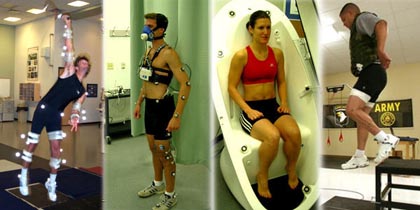 NMRL Testing Equipment
NMRL Testing Equipment
Strength Assessment: |
Postural Stability: |
Physiology Assessment: |
Biomechanics / Motion Analysis: |
Micellaneous Equipment: |
Strength Assessment:
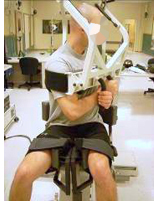 The Biodex System 3 is an isokinetic dynamometer used for the assessment of muscular strength. The NMRL has the attachments for the ankle, knee, hip, trunk, and shoulder allowing for strength and range of motion assessments of the upper and lower extremity. Researchers at the NMRL have developed novel testing protocols for the upper trapezius as well as for the scapular protractors and retractors using the Biodex closed kinetic chain attachment. Additionally, the NMRL has used this system to assess proprioception including joint position sense, force sense, and threshold to detect passive motion.
The Biodex System 3 is an isokinetic dynamometer used for the assessment of muscular strength. The NMRL has the attachments for the ankle, knee, hip, trunk, and shoulder allowing for strength and range of motion assessments of the upper and lower extremity. Researchers at the NMRL have developed novel testing protocols for the upper trapezius as well as for the scapular protractors and retractors using the Biodex closed kinetic chain attachment. Additionally, the NMRL has used this system to assess proprioception including joint position sense, force sense, and threshold to detect passive motion.
Past and current research using the Biodex System 3:
- - UPitt Warrior Human Performance Research
- - The relationship between musculoskeletal strength and physiological characteristics with changes in knee kinesthesia following fatiguing exercise
- - Strength and swing biomechanical characteristics in adult baseball hitters of different swing velocity
- - A comparison of physical characteristics and swing mechanics between golfers with and without a history of low back pain
- - Effect of peripheral fatigue on force sense of the knee
- - The effect of Kinesio tape on shoulder proprioception, scapular kinematics, and strength in subjects with and without subacromial impingement syndrome
- - Reliability and precision of hip proprioception methods in healthy individuals
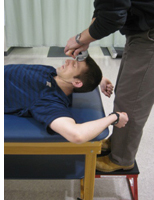 The Lafayette Manual Muscle Tester is a hand-held dynamometer (HHD) used to assess isometric muscle strength. This device has primarily been utilized in the NMRL to assess ankle and shoulder joint strength. Currently, researchers at the NMRL have developed novel testing protocols to assess the strength of cervical and scapular musculature.
The Lafayette Manual Muscle Tester is a hand-held dynamometer (HHD) used to assess isometric muscle strength. This device has primarily been utilized in the NMRL to assess ankle and shoulder joint strength. Currently, researchers at the NMRL have developed novel testing protocols to assess the strength of cervical and scapular musculature.
Past and current research using the HHD:
- - UPitt Warrior Human Performance Research
- - The relationship between strength, range of motion/flexibility, and posture with shoulder complex injuries in intercollegiate baseball and softball players
- - Injury risk factors for lower extremity injuries in collegiate men’s and women’s soccer and basketball
- - The effects of scapular kinematics during arm elevation, glenohumeral range of motion, and shoulder muscle strength on kinematics during baseball throwing
(Top)
Postural Stability Assessment:
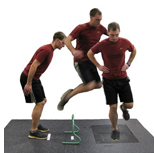 The NMRL has two portable Kistler force plates and one Bertec force plate. The force plates have been used to assess static postural stability during single-leg stance and dynamic postural stability during single-leg jump landings. Researchers at the NMRL have developed a novel rotational jump landing task to assess dynamic postural stability. Additionally, the NMRL has used force plates to assess ground reaction forces during drop landings, stop jumps, and lifting tasks to identify individuals who may be at risk for injury.
The NMRL has two portable Kistler force plates and one Bertec force plate. The force plates have been used to assess static postural stability during single-leg stance and dynamic postural stability during single-leg jump landings. Researchers at the NMRL have developed a novel rotational jump landing task to assess dynamic postural stability. Additionally, the NMRL has used force plates to assess ground reaction forces during drop landings, stop jumps, and lifting tasks to identify individuals who may be at risk for injury.
Past and current research using force plates
- - UPitt Warrior Human Performance Research
- - The relationship between functional ankle instability questionnaires and static and dynamic postural stability in previously injured and healthy controls
- - Dynamic postural stability during a rotational jump landing
- - An examination, correlation, and comparison of static and dynamic measures of postural stability in healthy, physically active adults
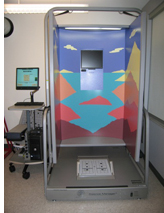 The NeuroCom Smart EquiTest consists of a dynamic force plate with rotation and translation capabilities as well as a visual surround that is capable of moving, thereby, testing the somatosensory, visual, vestibular systems used to maintain balance. Traditionally, the NeuroCom Smart EquiTest has been used in sports medicine research regarding concussions, however, the NMRL is among the first to use it as a predictor of musculoskeletal injury in athletic populations.
The NeuroCom Smart EquiTest consists of a dynamic force plate with rotation and translation capabilities as well as a visual surround that is capable of moving, thereby, testing the somatosensory, visual, vestibular systems used to maintain balance. Traditionally, the NeuroCom Smart EquiTest has been used in sports medicine research regarding concussions, however, the NMRL is among the first to use it as a predictor of musculoskeletal injury in athletic populations.
Past and current research using the NeuroCom Smart EquiTest
- - UPitt Warrior Human Performance Research
- - Correlation between NeuroCom Smart EquiTest measures of postural stability and traditional force plate measures of static and dynamic postural stability
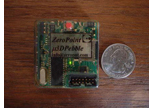 The NMRL has three wireless tri-axial accelerometers (±90g, ±18g, and ±16g). Historically accelerometers have been used to assess static postural stability and impact accelerations. The NMRL will be among the first to use accelerometers to evaluate dynamic postural stability in a young, healthy, physically active population. The NMRL has also used accelerometry to quantify the demand and impacts during specific sport and tactical tasks and activities.
The NMRL has three wireless tri-axial accelerometers (±90g, ±18g, and ±16g). Historically accelerometers have been used to assess static postural stability and impact accelerations. The NMRL will be among the first to use accelerometers to evaluate dynamic postural stability in a young, healthy, physically active population. The NMRL has also used accelerometry to quantify the demand and impacts during specific sport and tactical tasks and activities.
Past and current research using the NeuroCom
- - UPitt Warrior Human Performance Research
- - Accelerometry to evaluate postural control in multiple conditions
- - Correlation of proximal tibial acceleration with kinematic and kinetic variables during single-leg stop-jump and drop-landings
(Top)
Physiology Assessment:
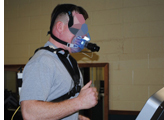 Maximal Oxygen Uptake (VO2max) is assessed at the NMRL using the Woodway Treadmill and the ParvoMedics TrueOne2400 metabolic unit. The Cosmed K4b2 portable metabolic unit and Viasys Oxycon Mobile metabolic unit allow for metabolic data collection during field testing and accommodate physiological demand analysis of specific tactical tasks and activities. Heart rate is assessed during VO2max and field testing with a Polar heart rate monitor. Lactate threshold is assessed during laboratory VO2max testing via blood lactate analysis with a LactatePro Lactate Meter.
Maximal Oxygen Uptake (VO2max) is assessed at the NMRL using the Woodway Treadmill and the ParvoMedics TrueOne2400 metabolic unit. The Cosmed K4b2 portable metabolic unit and Viasys Oxycon Mobile metabolic unit allow for metabolic data collection during field testing and accommodate physiological demand analysis of specific tactical tasks and activities. Heart rate is assessed during VO2max and field testing with a Polar heart rate monitor. Lactate threshold is assessed during laboratory VO2max testing via blood lactate analysis with a LactatePro Lactate Meter.
Past and current research using VO2max/Lactate Threshold assessment:
- - UPitt Warrior Human Performance Research
- - Effects of Maximal Aerobic and Anaerobic Exercise Bouts on Heart Rate Recovery and Postural Control
- - The Relationship between Musculoskeletal Strength and Physiological Characteristics with Changes in Knee Kinesthesia following Fatiguing Exercise
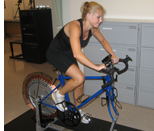 The Velotron Electromagnetic Cycle Ergometer is used to assess anaerobic power and capacity. Researchers at the NMRL utilize a 30-second Wingate protocol in order to assess these anaerobic parameters.
The Velotron Electromagnetic Cycle Ergometer is used to assess anaerobic power and capacity. Researchers at the NMRL utilize a 30-second Wingate protocol in order to assess these anaerobic parameters.
Past and current research using Wingate assessment:
- - UPitt Warrior Human Performance Research
- - Pittsburgh Penguin Professional Hockey Club Performance Assessment
- - Effects of maximal aerobic and anaerobic exercise bouts on heart rate recovery and postural control
BOD POD Body Composition System
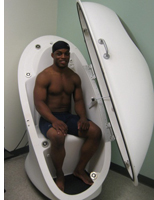 The BOD POD Body Composition System is used to estimate fat and fat-free mass. This device uses air displacement plethysmography to quickly and accurately assess body composition (% body fat).
The BOD POD Body Composition System is used to estimate fat and fat-free mass. This device uses air displacement plethysmography to quickly and accurately assess body composition (% body fat).
Past and current research using BOD POD assessment:
- - UPitt Warrior Human Performance Research
- - Less body fat improves physical and physiological performance in Army Soldiers
- - Pittsburgh Steeler professional football club body composition assessment
- - University of Pittsburgh women’s basketball body composition assessment
(Top)
Biomechanical / Motion Analysis:
![]() The NMRL has an 8-camera Vicon Nexus system to capture 3D motion analysis. The Vicon Nexus system is fully integrated with force plates, electromyography (EMG), and accelerometers. While commonly used to capture 3D motion analysis the NMRL has developed novel testing procedures to assess proprioception of the trunk and shoulder.
The NMRL has an 8-camera Vicon Nexus system to capture 3D motion analysis. The Vicon Nexus system is fully integrated with force plates, electromyography (EMG), and accelerometers. While commonly used to capture 3D motion analysis the NMRL has developed novel testing procedures to assess proprioception of the trunk and shoulder.
Past and current research using Vicon assessment:
- - UPitt Warrior Human Performance Research
- - Correlation of proximal tibial acceleration with kinematic and kinetic variables during single-leg, stop-jump and drop-landings
- - Minimal additional weight of combat equipment alters Air Assault Soldiers’ landing biomechanics
- - Predictors of proximal tibia anterior shear force during a vertical stop-jump
- - Fatigue alters lower extremity kinematics during a single-leg stop-jump task
- - A comparison of physical characteristics and swing mechanics between golfers with and without a history of low back pain
- - The relationship between biomechanical variables and driving performance during the golf swing
MotionStar Electromagnetic Tracking Device
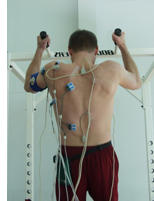 The MotionStar electromagnetic tracking device is integrated with the MotionMonitor motion-capture software and is used to assess human movement during dynamic tasks. Commonly, in the NMRL the MotionStar electromagnetic tracking device is used concomitantly with surface electromyography (EMG) and/or force plates.
The MotionStar electromagnetic tracking device is integrated with the MotionMonitor motion-capture software and is used to assess human movement during dynamic tasks. Commonly, in the NMRL the MotionStar electromagnetic tracking device is used concomitantly with surface electromyography (EMG) and/or force plates.
Past and current research using the MotionStar electromagnetic tracking device:
- - UPitt Warrior Human Performance Research
- - Postural stability and isokinetic strength do not predict knee valgus angle during single-leg drop-landing or single-leg squat in elite male rugby union players
- - Reliability and precision of in vivo scapular kinematic measurements using an electromagnetic tracking device
- - Scapular position and orientation in throwing athletes
- - Kinematic analysis of the hip and trunk during bilateral stance on firm, foam, and multiaxial support surfaces
- - Comparison of the ankle, hip, and trunk corrective action shown during single-leg stance on firm, foam, and multiaxial surfaces
- - Gender differences in strength and lower extremity kinematics during landing
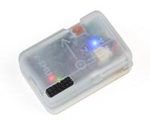 The inertial measurement unit (IMU) includes a 3D linear accelerometer, 3D angular rate sensor (gyroscope), and a 3D magnetometer. The IMU is capable of measuring joint kinematics outside of the laboratory setting during real world activities. The NMRL is using the IMU to collect kinematic data during sport specific tasks in the field.
The inertial measurement unit (IMU) includes a 3D linear accelerometer, 3D angular rate sensor (gyroscope), and a 3D magnetometer. The IMU is capable of measuring joint kinematics outside of the laboratory setting during real world activities. The NMRL is using the IMU to collect kinematic data during sport specific tasks in the field.
Past and current research using IMUs assessment:
- - Evaluation of instrumented soccer equipment to collect ankle joint kinematics in the field
- - Evaluation of IMUs to collect scapular and humeral kinematics
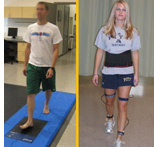 The NMRL uses the Emed and Pedar systems to measure plantar pressure during static and dynamic activities. The Emed system is a pedobarographic platform that consists of a 4m walkway and is used to assess the foot-ground interface. The Pedar system allows for portable plantar pressure measurements during dynamic activities such as walking and running and is used to assess the foot-shoe interface.
The NMRL uses the Emed and Pedar systems to measure plantar pressure during static and dynamic activities. The Emed system is a pedobarographic platform that consists of a 4m walkway and is used to assess the foot-ground interface. The Pedar system allows for portable plantar pressure measurements during dynamic activities such as walking and running and is used to assess the foot-shoe interface.
Past and current research using Novel assessment:
- - Within trial and between trials reliability of plantar pressure measurements in ambulatory adults using the Emed and Pedar systems.
- - Optimal number of trials required to obtain reliable plantar pressure measurements utilizing a two-step approach
- - Reliability of dynamic foot geometry assessment using a pedobarographic platform and a two-step approach
- - Reliability of in-sole plantar pressure using simple and detailed masks of the forefoot, midfoot, and hindfoot
- - Comparison of plantar pressure measurements obtained during barefoot and shod conditions
(Top)
Micellaneous Equipment:
 The NMRL has two wireless surface electromyography (EMG) systems (Zero wire and TelaMyo) to assess muscle activity. The wireless systems consist of one small transmitter for each pair electrodes and has the capability of recording muscle activity for up to eight muscles simultaneously.
The NMRL has two wireless surface electromyography (EMG) systems (Zero wire and TelaMyo) to assess muscle activity. The wireless systems consist of one small transmitter for each pair electrodes and has the capability of recording muscle activity for up to eight muscles simultaneously.
Past and current research using EMG:
- - Local anaesthetics use does not suppress muscle activity following an ankle injection
- - Validation study of a lower extremity musculoskeletal model for drop landing and stop jump tasks
- - Three-dimensional scapular and clavicular kinematics and scapular muscle activity during retraction exercises
- - Reliability and precision of EMG in leg, torso, and arm muscles during running
- - Predictors of proximal tibia anterior shear force during a vertical stop-jump
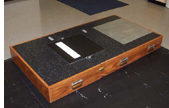 The NMRL has a custom built ankle perturbation device. The aluminum tilt plate is controlled by a stepper-motor and custom computer program (LabView) that automatically drives the unlocking/locking mechanism. The amplitude of the inversion perturbation is held at 20°. The ankle perturbation device has allowed researchers at the NMRL to conduct research studies that simulate lateral ankle sprains during dynamic tasks.
The NMRL has a custom built ankle perturbation device. The aluminum tilt plate is controlled by a stepper-motor and custom computer program (LabView) that automatically drives the unlocking/locking mechanism. The amplitude of the inversion perturbation is held at 20°. The ankle perturbation device has allowed researchers at the NMRL to conduct research studies that simulate lateral ankle sprains during dynamic tasks.
Past and current research using the ankle perturbation device:
- - Local anaesthetics use does not suppress muscle activity following an ankle injection
- - Effects of selected modes of prophylactic support on reflex muscle firing following dynamic perturbation of the ankle
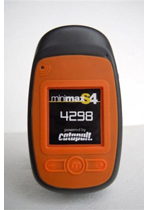 The Minimax device (by Catapult systems) uses GPS, 3D accelerometer, 3D gyroscope, and 3D magnetometers in one small device that can also collect heart rate, allowing for a complete picture of physiological and physical demand of an athlete or tactical operator. The NMRL is using the Minimax device to collect data during field testing of specific tactical tasks and activities in attempts to develop laboratory tasks that mimic common military tactical tasks and activities. The information obtained from the Minimax may also lead to the implementation of training programs that better prepare the operator for tactical tasks and activities.
The Minimax device (by Catapult systems) uses GPS, 3D accelerometer, 3D gyroscope, and 3D magnetometers in one small device that can also collect heart rate, allowing for a complete picture of physiological and physical demand of an athlete or tactical operator. The NMRL is using the Minimax device to collect data during field testing of specific tactical tasks and activities in attempts to develop laboratory tasks that mimic common military tactical tasks and activities. The information obtained from the Minimax may also lead to the implementation of training programs that better prepare the operator for tactical tasks and activities.
Past and current research using the Mini-max:
- - UPitt Warrior Human Performance Research
(Top)